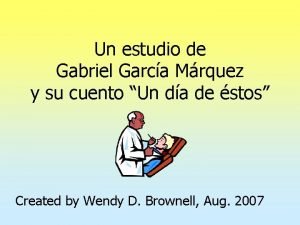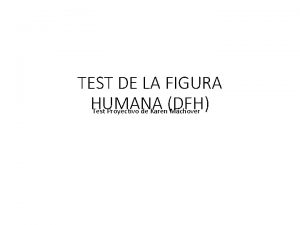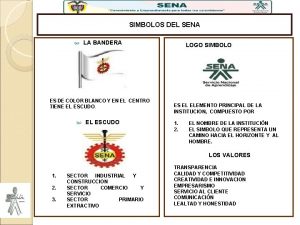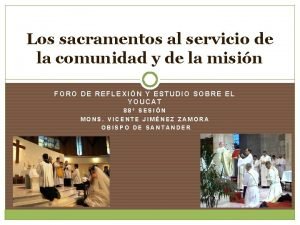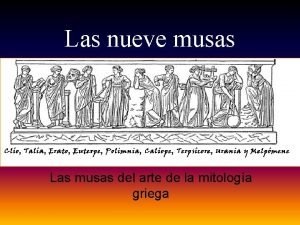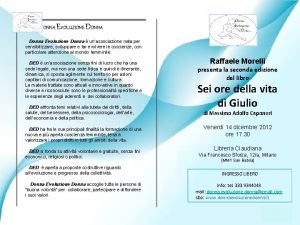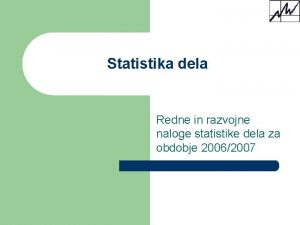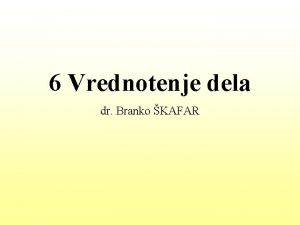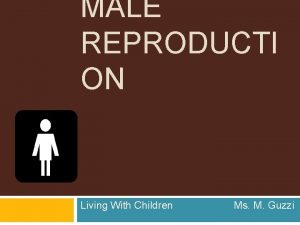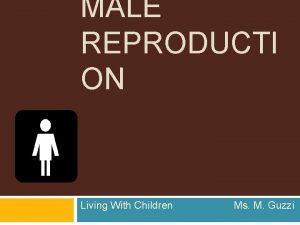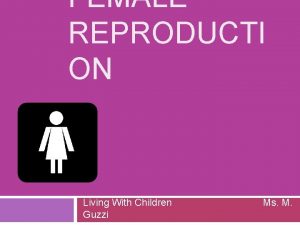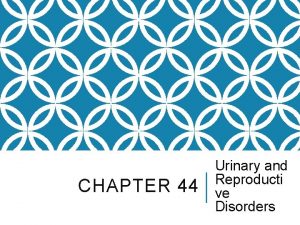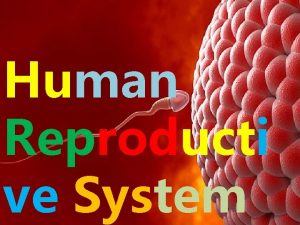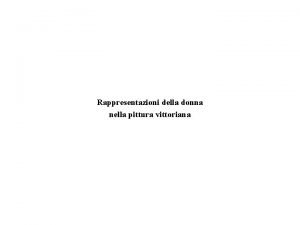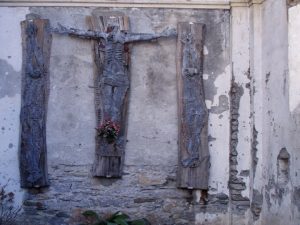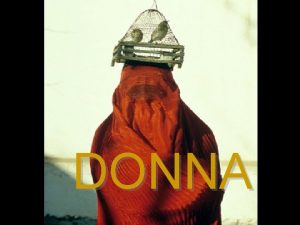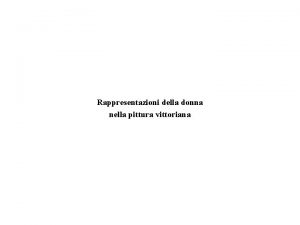The Reproducti ve Process Donna May dela CruzPapa




















































- Slides: 52

The Reproducti ve Process… Donna May dela Cruz-Papa College of Science University of Santo Tomas

“Omne vivum ex ovo” “all life developed from the egg” - W. Harvey

Nature of the reproductive process A. Mechanisms 1. Asexual reproduction - involves only one parent - no special reproductive organs or cells involved - Genetically identical offspring are produced - Production of offspring is simple, direct and rapid 2. Sexual reproduction - involves two parents - gametes unite to form a zygote - Unique offspring = genetic material from both parents - Sexual reproduction recombines parental characters and makes possible a richer and more diversified population.

Mutation Asexual : - mutations are expressed and selected quickly Sexual : - a normal gene on the homologous chromosome may mask a gene mutation

Asexual reproduction • • Reproduction Without Gametes Neither eggs nor sperm are involved Unless mutations occur, all offspring have the same genotype and are called Clones widespread in - bacteria - unicellular eukaryotes - invertebrates ensures rapid increase in numbers

Asexual reproduction • Binary fission • Budding • Gemmulation • Fragmentation

Binary fission • common among bacteria and protozoa • parent divides by mitosis into two parts; each grows into an individual similar to the parent • can be lengthwise or transverse • In multiple fission - nucleus divides repeatedly; cytoplasmic division produces many daughter cells • Sporogony is spore formation, a form of multiple fission in parasitic protozoa.

Budding • unequal division of an organism • bud - an outgrowth of the parent -develops organs and then detaches • Cnidarians and some other animal phyla

Gemmulation • formation of a new individual from an aggregation of cells from the parent individual surrounded by a resistant capsule (gemmule) • Freshwater sponges survive winter in the dried or frozen body of the parent • In good conditions, the enclosed cells become active, emerge and grow a new sponge

Fragmentation • involves a multicellular animal breaking into many fragments that become a new animal • seen in many anemones and hydroids

sexual reproduction • Reproduction With Gametes Bisexual reproduction Hermaphroditism Parthenogenesis

Bisexual reproduction • Aka biparental • produces offspring from union of gametes from two genetically different parents

• Offspring therefore have a genotype different from either parent • Male = spermatozoa ; female = ova • Ovum - large with stored yolk and is nonmotile. • spermatozoon - small, motile and much more numerous • Dioecious – separate sexes (vertebrates & inverts) • Monoecious / hermaphrodites – both male and female organs • Meiosis (duplication and two divisions) produces four haploid cells • Fertilization - 2 haploid cells combine to restore the diploid chromosome # • Zygote divides by mitosis for all somatic (body) cells • Conjugation - When sexual parents merely join together to exchange nuclear material

• Organs that produce germ cells are gonads; testes produce sperm and ovaries produce eggs • Gonads - primary sex organs • Additional accessory sex organs include penis, vagina, uterine tubes and uterus.

Hermaphroditism • have both male and female Simultaneous organs in the same individual hermaphrodites • Many sessile, burrowing and/or endoparasitic invertebrate animals and a few fish are hermaphroditic • Each individual is reproductive, in contrast to dioecious species where about half is male

• In sequential hermaphroditism, a fish starts life as one sex and is genetically programmed to change to the other sex later CLOWNFISH have both male and female sex organs, but they develop and mature at different points in the lifecycle. Most species only change sex once in their development. As a result, these organism still need another individual at the opposite stage for fertili. Zation

Parthenogenesis • development of an embryo from an unfertilized egg • Male and female nuclei may fail to unite after fertilization • ameiotic parthenogenesis - no meiosis occurs ; the egg forms by mitotic division • meiotic parthenogenesis - haploid ovum is formed by meiosis and develops without fusion with the male nuclei Reasons : - Sperm may be absent or they may only activate development - in some species, haploid egg returns to a diploid condition by chromosomal duplication

• Haplodiploidy occurs in bees, wasps and ants - The queen controls whether the eggs are laid fertilized or unfertilized - Fertilized eggs become female workers or queens - the unfertilized eggs become drones (male)

Why do so many animals reproduce sexually rather than asexually? Inferred to be highly advantageous? a. b. 1) 2) 3) c. d. e. f. g. Sexual reproduction is more common among animals The costs of sexual reproduction are greater more complicated, requires more time & uses more energy than asexual The cost of meiosis to the female is passage of only half of her genes to offspring Production of males reduces resources for females that could produce eggs Sexual organisms produce more novel genotypes to survive in times of environmental change Asexual organisms can have more offspring in a short time to colonize new environments In crowded habitats, selection is intense and diversity prevents extinction On a geological time scale, asexual lineages with less variation are prone to extinction Many invertebrates with both sexual and asexual modes enjoy the advantages of both

Origin and Maturation of Germ Cells • Somatic cells are non-reproductive body cells; they differentiate, function and die before or with the animal • Germ cells form gametes; the germ cell line provides a continuous line between generations • Somatic cells support, protect and nourish the germ cell line • The germ cell lineage may be traceable; in some invertebrates, the germ cells develop from somatic cell

Migration of Germ Cells • Vertebrate gonads arise from a pair of genital ridges that grows into the coelom • Primordial germ cells - future stock of gametes for an animal • Germ plasm from the vegetal pole of the uncleaved egg mass moves to gut endoderm and migrates by ameboid movement to genital ridges

Sex Determination • Human males - SRY (sex determining region Y) on Y chromosome - organizes the gonad into a testis • Testis - secretes testosterone with dihydrotestosterone (DHT), masculinizes the fetus dev’t of penis, scrotum and male glands • In the brain, testosterone is enzymatically converted to Estrogen, Estrogen which determines brain organization for male-typical behavior • DDS (dosage sensitive sex reversal) or SRVX (sex reversing X) - region of X chrom. promote ovary formation • Absence of testosterone in a genetic female embryo dev’t of vagina, clitoris and uterus • Despite levels of estrogen, the female brain does not become masculinized perhaps due to low estrogen receptors

Gametogenesis • Gametogenesis is the series of transformations that result in gametes. • Testes carry out spermatogenesis; ovaries carry out oogenesis

Spermatogenesis a. The wall of seminiferous tubules contains germ cells five to eight cells deep b. Sertoli (sustentacular) cells extend from the periphery to nourish germ cells c. Outermost layers are spermatogonia diploid cells increased by mitosis d. spermatogonium - becomes primary spermatocyte e. 1° - undergoes M 1 = two 2° f. Each 2° enters M 2 = produce 4 haploid spermatids g. Spermatids transform into mature spermatozoa (sperm)


How are sperms formed, really? 1) Most cytoplasm is lost. 2) The haploid nucleus condenses into a head 3) A midpiece forms containing mitochondria. 4) The whiplike flagellar tail provides locomotion. 5) The sperm head contains an acrosome (except for some fishes and invertebrates). ***Often the acrosome contains lysins to clear an entrance through layers surrounding the egg

• In mammals, one lysin is hyaluronidase - allows sperm to penetrate follicular cells around egg • Most invertebrate sperm, an acrosome filament extends suddenly upon contact with egg • Fusion of egg and sperm plasma membranes is the initial event for fertilization. • Sperm greatly outnumber eggs.

Oogenesis Oogonia are early germ cells in the ovary; they are diploid and increase by mitosis primary oocytes Larger daughter cell or 2° oocyte receives most of the cytoplasm; the rest goes to the first polar body M 2 - 2° oocyte forms a large ootid and a small polar body also divides = three polar bodies that eventually disintegrate ootid forms a functional ovum with sufficient yolk oogenesis forms one haploid ovum **Most vertebrate and some invertebrate eggs wait for fertilization to complete the last meiotic divisions.

Development is arrested in prophase I in the primary oocyte phase; meiosis resumes at ovulation or after fertilization - Human ova begin M 1 at the 13 th week of fetal dev’t - Human ova arrest development in prophase I until puberty - After puberty, some oocytes develop into 2° oocytes - M 2 is completed only after penetration by a spermatozoon

Egg Yolk 1) Egg maturation involves deposition of yolk. 2) Yolk is stored as granules of lipid, protein or both. 3) Yolk may be synthesized internally or supplied from follicle cells. 4) Accumulation of yolk granules and nutrients cause eggs to grow massively beyond normal cell size

Reproductive Patterns Oviparous animals lay eggs in the env’t for dev’t • Fertilization may be internal (before eggs are laid) or external (after laid) • Some animals abandon eggs; others provide extensive care Ovoviviparous animals retain eggs in their body • Essentially all nourishment is derived from the yolk • Common in some invertebrate groups and certain fishes and reptiles • Fertilization is internal Viviparous animals give live birth • Eggs develop in an oviduct or uterus. • Embryos continuously derive nourishment from the mother • Fertilization is internal • occurs in mammals & some fishes; provides more protection to offspring.

Structure of Reproductive Systems Components • Primary organs - the gonads that produce sperm, eggs and sex hormones • Accessory organs - assist gonads in formation and delivery of gametes and may support embryos

Invertebrate Reproductive Systems • Invertebrates that transfer sperm for internal fertilization require complex organs • Invertebrates that release sperm into water for external fertilization may be simple - Polychaete annelids have no permanent reproductive organs; gametes are cells from the body cavity - Mature gametes may be released through ducts or spill out through ruptures

Insects • separate sexes • accomplish internal fertilization using complex systems - Sperm - stored in seminal vesicles before ejaculated - Female have ovaries in a series of egg tubes - Mature ova pass to a common genital chamber and short vagina - Sperm inserted by male are stored in a seminal receptacle in female - One mating may provide enough sperm to last the reproductive life of a female insect

Vertebrate Reproductive Systems Urogenital system - show close connections of reproductive and excretory systems Mesonephric duct - drains the kidney and carries sperm in male fishes and amphibians - composed of the vas deferens - a separate ureter develops in male reptiles, birds and mammals Cloaca - common chamber for intestinal, reproductive and excretory canals, except in mammals Uterine duct of the oviduct - has an independent duct opening into cloaca when present

Male Reproductive System 1. Paired testes - sites of sperm production 2. Testes contain numerous seminiferous tubules where sperm develop. 3. Sperm are surrounded by Sertoli cells that nourish developing sperm 4. Between tubules are interstitial cells (leydig cells) that produce testosterone.

5. A sac-like scrotum suspends testes outside the warm body cavity; lower temperature of scrotum is vital to normal sperm production 6. Sperm pass from the testes to vasa efferentia and to coiled epididymis for maturation. 7. The vas deferens carries sperm from the epididymis to the urethra, where it exits the penis. 8. The penis is a copulatory organ used to introduce spermatozoa into the female vagina. 9. Seminal vesicles, prostate gland bulbourethral glands form seminal fluid. a. Seminal vesicles secrete a thick fluid containing nutrients for use by sperm. b. The prostate gland secretes a milky, slightly alkaline solution that counters acidity. c. Bulbourethral glands release mucus secretions that provide lubrication.

1. 2. 3. Female Reproductive System Ovaries - produce ova and sex hormones; estrogen and progesterone Jawed vertebrates - mature ova from ovaries enter funnel-like uterine tubes or oviducts Terminal end of uterine tube is specialized in cartilaginous fishes, reptiles and birds to produce shelled eggs; special regions produce albumin and shell 4. a. b. c. 5. The terminal portion uterine tube expands into a muscular uterus. Shelled eggs may be retained Embryos may complete their development Placental mammals use the walls of the uterus to intermingle vascular tissue as a placenta. Ovaries are paired and slightly smaller than male testes

**Unless fertilization occurs, women release about 13 oocytes per year, 300– 400 per a 30 year reproductive lifetime **300– 400 primary oocytes reach maturity while the rest degenerate and are absorbed

Uterus • specialized to house the embryo for nine months • has thick muscular walls and is stretchable • endometrium is the specialized lining rich in blood vessels. vagina - muscular tube that receives the male’s penis and serves as birth canal cervix - end of the uterus that extends into the vagina vulva - external genitalia in human females • a. Labia majora and labia minora enclose urethral and vaginal openings. • b. The clitoris is a small erectile organ equivalent to the glans penis of male.

Endocrine Events that Orchestrate Reproduction Hormonal Control of Timing of Reproductive Cycles 1. Vertebrate reproduction is seasonal or cyclic to align with food supply and survival of young 2. Sexual cycles are controlled by hormones that respond to food intake, photoperiod, rainfall, temperature or social cues 3. The hypothalamus region of the forebrain regulates the release of anterior pituitary gland hormones, which stimulate tissues of the gonads

Estrous Cycles (in heat) a. Females are receptive to males only during brief periods of estrus or “heat. ” b. The estrous cycle ends with uterine lining reverting to original state; there is no menstruation Menstrual Cycles a. This cycle occurs in monkeys, apes and humans b. Females are receptive to males throughout the cycle. c. At the end of the menstrual cycle the endometrium (uterine lining) is discharged

Gonadal Steroids and Their Control 1. Ovaries produce estrogens and progesterone 2. The three estrogens : estradiol, estrone and estriol Estrogen Functions a. develop female accessory sex structures: oviducts, uterus and vagina b. stimulate female reproductive activity c. Secondary non-reproductive characteristics include 1) skin or feather coloration 2) bone development 3) body size, and 4) initial development of mammary glands in mammals Both estrogen and progesterone prepare the uterus to receive an embryo • The hypothalamus produces gonadotropin releasing hormone (Gn. RH) - governs pituitary release of follicle-stimulating hormone (FSH) and luteinizing hormone (LH)

Testosterone a. Interstitial cells - manufacture testosterone. b. Testosterone and its metabolite dihydrotestosterone (DHT) are required for growth of the penis, sperm ducts, and glands, and secondary sexual traits c. Secondary non-reproductive characteristics include 1) male plumage and pelage coloration, 2) bone and muscle growth, 3) antlers in deer, and 4) vocal cord growth in humans d. Testosterone and DHT feedback to hypothalamus and anterior pituitary to keep secretion of Gn. RH, FSH and LH in check e. Sertoli cells of testes secrete inhibin; regulates FSH of anterior pituitary

The Menstrual Cycle Ovary has two phases: a. follicular (release – ovulation, day 13 -14) b. luteal – endometrium degeneration (menstrual discharge) Menstruation, shedding of the uterine lining, signals the menstrual phase

Hormones of Human Pregnancy and Birth • Preparation of mammary glands to secrete milk requires two additional hormones • Prolactin (PRL) & lactogen (h. PL) - aids PRL in preparing the mammary glands for secretion • h. PL - stimulates an increase in nutrients in the mother • -endorphin - regulate appetite and mood during pregnancy • Relaxin - dilates the cervix in preparation for delivery

Birth or parturition begins with rhythmic contractions of uterus called labor • Placental corticotropin-releasing hormone (CRH) appears to initiate the birth process • Estrogen secreted before birth stimulates contractions • Progesterone levels, which inhibit contraction, decline • Prostaglandin hormones increase, making the uterus more irritable • Oxytocin stimulates uterine smooth muscle contractions

Childbirth 1) First stage: the cervix enlarges and the amniotic sac will rupture. 2) Second stage: the baby is forced out of the uterus and through the vagina. 3) Third stage: the placenta or afterbirth is expelled.

Milk Production 1) triggered when infant sucks on the mother’s nipple 2) Oxytocin causes contraction of smooth muscles lining ducts of mammary glands 3) Suckling also stimulates release of prolactin, which continues milk production.

Multiple Births 1. 2. 3. 4. 5. Many mammals are multiparous, giving birth to many offspring at one time Some give birth only to one at a time; they are uniparous. Exceptions occur; the armadillo gives birth to four young, all male or all female, derived from one zygote Monozygotic, or identical, twins are derived from one zygote; they have identical genomes Fraternal, dizygotic or nonidentical, twins are from two zygotes and may not resemble each other any more than other siblings.


Identical Twins • Identical/monozygotic twins come from one zygote • Non-identical / dizygotic / fraternal – 2 zygotes & do not resemble each other a. may separate early and have separate placentas b. Two-thirds share a placenta and splitting occurred after formation of the inner cell mass, but most have individual amniotic sacs
 Hci patterns may or may not include code for implementation
Hci patterns may or may not include code for implementation Hát kết hợp bộ gõ cơ thể
Hát kết hợp bộ gõ cơ thể Bổ thể
Bổ thể Tỉ lệ cơ thể trẻ em
Tỉ lệ cơ thể trẻ em Gấu đi như thế nào
Gấu đi như thế nào Chụp tư thế worms-breton
Chụp tư thế worms-breton Chúa sống lại
Chúa sống lại Các môn thể thao bắt đầu bằng từ đua
Các môn thể thao bắt đầu bằng từ đua Thế nào là hệ số cao nhất
Thế nào là hệ số cao nhất Các châu lục và đại dương trên thế giới
Các châu lục và đại dương trên thế giới Công thức tính thế năng
Công thức tính thế năng Trời xanh đây là của chúng ta thể thơ
Trời xanh đây là của chúng ta thể thơ Cách giải mật thư tọa độ
Cách giải mật thư tọa độ 101012 bằng
101012 bằng độ dài liên kết
độ dài liên kết Các châu lục và đại dương trên thế giới
Các châu lục và đại dương trên thế giới Thể thơ truyền thống
Thể thơ truyền thống Quá trình desamine hóa có thể tạo ra
Quá trình desamine hóa có thể tạo ra Một số thể thơ truyền thống
Một số thể thơ truyền thống Bàn tay mà dây bẩn
Bàn tay mà dây bẩn Vẽ hình chiếu vuông góc của vật thể sau
Vẽ hình chiếu vuông góc của vật thể sau Nguyên nhân của sự mỏi cơ sinh 8
Nguyên nhân của sự mỏi cơ sinh 8 đặc điểm cơ thể của người tối cổ
đặc điểm cơ thể của người tối cổ V. c c
V. c c Vẽ hình chiếu đứng bằng cạnh của vật thể
Vẽ hình chiếu đứng bằng cạnh của vật thể Vẽ hình chiếu vuông góc của vật thể sau
Vẽ hình chiếu vuông góc của vật thể sau Thẻ vin
Thẻ vin đại từ thay thế
đại từ thay thế điện thế nghỉ
điện thế nghỉ Tư thế ngồi viết
Tư thế ngồi viết Diễn thế sinh thái là
Diễn thế sinh thái là Dạng đột biến một nhiễm là
Dạng đột biến một nhiễm là Số.nguyên tố
Số.nguyên tố Tư thế ngồi viết
Tư thế ngồi viết Lời thề hippocrates
Lời thề hippocrates Thiếu nhi thế giới liên hoan
Thiếu nhi thế giới liên hoan ưu thế lai là gì
ưu thế lai là gì Sự nuôi và dạy con của hươu
Sự nuôi và dạy con của hươu Khi nào hổ mẹ dạy hổ con săn mồi
Khi nào hổ mẹ dạy hổ con săn mồi Hệ hô hấp
Hệ hô hấp Từ ngữ thể hiện lòng nhân hậu
Từ ngữ thể hiện lòng nhân hậu Thế nào là mạng điện lắp đặt kiểu nổi
Thế nào là mạng điện lắp đặt kiểu nổi Carta de despedida gabriel garcía márquez wikipedia
Carta de despedida gabriel garcía márquez wikipedia Boca cóncava
Boca cóncava Preguntas de sor juana inés dela cruz
Preguntas de sor juana inés dela cruz Los colores dela bandera del sena
Los colores dela bandera del sena Sanjarjenje schumann
Sanjarjenje schumann Cuales son los sacramentos al servicio de la comunidad
Cuales son los sacramentos al servicio de la comunidad Personajes secundarios de don quijote
Personajes secundarios de don quijote Las 9 musas
Las 9 musas Las siete copas de la ira de dios
Las siete copas de la ira de dios Je connais un pays
Je connais un pays










































